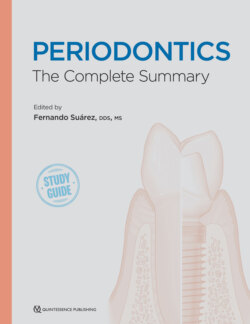Читать книгу Periodontics - Fernando Suarez - Страница 60
На сайте Литреса книга снята с продажи.
Necrotizing Periodontal Diseases
ОглавлениеNecrotizing periodontal diseases belong to a group of acute lesions occurring in the periodontium and can be divided into necrotizing gingivitis (formerly referred to as necrotizing ulcerative gingivitis) and necrotizing periodontitis (formerly referred to as necrotizing ulcerative periodontitis).76 Currently available evidence suggests that given the similar etiology, clinical features, and treatment, these entities may represent different stages of the same disease and may even progress to more severe forms such as necrotizing stomatitis and noma.76
Necrotizing periodontal diseases are associated with impairment in the host immune response and typically present with three clinical features: papilla necrosis, pain, and bleeding. Other signs and symptoms may include halitosis, pseudomembranes, regional lymphadenopathy, fever, sialorrhea, and rapid bone loss in cases of necrotizing periodontitis. Necrotizing stomatitis is a more severe inflammatory condition that courses with soft tissue necrosis beyond the gingiva, osteitis, and bone sequestrum.1
Similar to other forms of periodontitis, the etiology of necrotizing periodontal diseases is a bacterial infection; however, several other predisposing factors and immune-related conditions play a role in the pathogenesis.76
